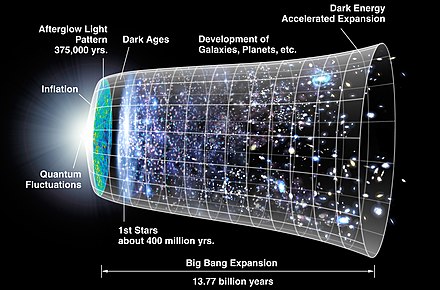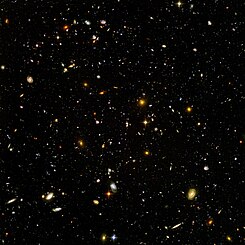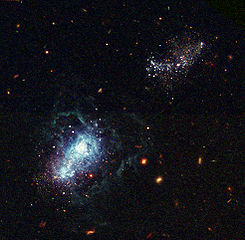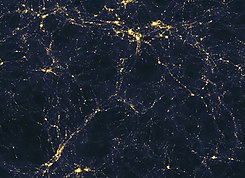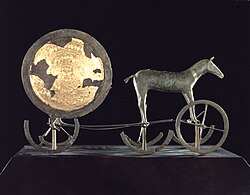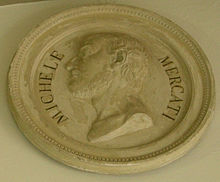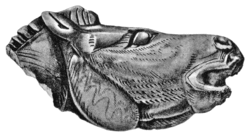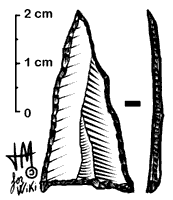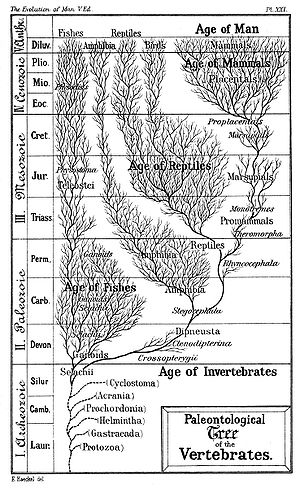The chronology of the universe describes the history and future of the universe according to Big Bang cosmology. The earliest stages of the universe's existence are estimated as taking place 13.8 billion years ago, with an uncertainty of around 21 million years at the 68% confidence level.
Outline
Chronology in five stages
For the purposes of this summary, it is convenient to divide the chronology of the universe since it originated, into five parts. It is generally considered meaningless or unclear whether time existed before this chronology:
The first picosecond (10−12) of cosmic time. It includes the Planck epoch, during which currently understood laws of physics may not apply; the emergence in stages of the four known fundamental interactions or forces—first gravitation, and later the electromagnetic, weak and strong interactions; and the expansion of space itself and supercooling of the still immensely hot universe due to cosmic inflation, which is believed to have been triggered by the separation of the strong and electroweak interaction.
Tiny ripples in the universe at this stage are believed to be the
basis of large-scale structures that formed much later. Different
stages of the very early universe are understood to different extents.
The earlier parts are beyond the grasp of practical experiments in particle physics but can be explored through other means.
Lasting around 370,000 years. Initially, various kinds of subatomic particles are formed in stages. These particles include almost equal amounts of matter and antimatter, so most of it quickly annihilates, leaving a small excess of matter in the universe.
At about one second, neutrinos decouple; these neutrinos form the cosmic neutrino background (CνB). If primordial black holes exist, they are also formed at about one second of cosmic time. Composite subatomic particles emerge—including protons and neutrons—and from about 2 minutes, conditions are suitable for nucleosynthesis: around 25% of the protons and all the neutrons fuse into heavier elements, initially deuterium which itself quickly fuses into mainly helium-4.
By 20 minutes, the universe is no longer hot enough for nuclear fusion, but far too hot for neutral atoms to exist or photons to travel far. It is therefore an opaque plasma. At around 47,000 years, as the universe cools, its behaviour begins to be dominated by matter rather than radiation. At about 100,000 years, helium hydride is the first molecule. (Much later, hydrogen and helium hydride react to form molecular hydrogen, the fuel needed for the first stars.)
At about 370,000 years, the universe finally becomes cool enough for neutral atoms to form ("recombination"), and as a result it also became transparent for the first time. The newly formed atoms—mainly hydrogen and helium with traces of lithium—quickly reach their lowest energy state (ground state) by releasing photons ("photon decoupling"), and these photons can still be detected today as the cosmic microwave background (CMB). This is currently the oldest observation we have of the universe.
From 370,000 years until about 1 billion years. After recombination and decoupling, the universe was transparent but the clouds of hydrogen only collapsed very slowly to form stars and galaxies,
so there were no new sources of light. The only photons
(electromagnetic radiation, or "light") in the universe were those
released during decoupling (visible today as the cosmic microwave
background) and 21 cm radio emissions
occasionally emitted by hydrogen atoms. The decoupled photons would
have filled the universe with a brilliant pale orange glow at first,
gradually redshifting to non-visible wavelengths after about 3 million years, leaving it without visible light. This period is known as the cosmic Dark Ages.
Between about 10 and 17 million years the universe's average
temperature was suitable for liquid water 273–373 K (0–100 °C) and there
has been speculation whether rocky planets or indeed life could have
arisen briefly, since statistically a tiny part of the universe could
have had different conditions from the rest as a result of a very
unlikely statistical fluctuation, and gained warmth from the universe as
a whole.
At some point around 200 to 500 million years, the earliest
generations of stars and galaxies form (exact timings are still being
researched), and early large structures gradually emerge, drawn to the
foam-like dark matter filaments which have already begun to draw together throughout the universe. The earliest generations of stars have not yet been observed astronomically. They may have been huge (100-300 solar masses) and non-metallic, with very short lifetimes compared to most stars we see today, so they commonly finish burning their hydrogen fuel and explode as highly energetic pair-instability supernovae after mere millions of years.
Other theories suggest that they may have included small stars, some
perhaps still burning today. In either case, these early generations of
supernovae created most of the everyday elements we see around us today, and seeded the universe with them.
Galaxy clusters and superclusters emerge over time. At some point, high energy photons from the earliest stars, dwarf galaxies and perhaps quasars leads to a period of reionization
that commences gradually between about 250-500 million years, is
complete by about 700-900 million years, and diminishes by about 1
billion years (exact timings still being researched). The universe
gradually transitioned into the universe we see around us today, and the
Dark Ages only fully came to an end at about 1 billion years.
From 1 billion years, and for about 12.8 billion years, the universe
has looked much as it does today. It will continue to appear very
similar for many billions of years into the future. The thin disk of our galaxy began to form at about 5 billion years (8.8 Gya), and our Solar System formed at about 9.2 billion years (4.6 Gya), with the earliest traces of life on Earth emerging by about 10.3 billion years (3.5 Gya).
From about 9.8 billion years of cosmic time, the slowing expansion of space gradually begins to accelerate under the influence of dark energy, which may be a scalar field
throughout our universe. The present-day universe is understood quite
well, but beyond about 100 billion years of cosmic time (about 86
billion years in the future), uncertainties in current knowledge mean
that we are less sure which path our universe will take.
At some time the Stelliferous Era will end as stars are no longer being born, and the expansion of the universe will mean that the observable universe becomes limited to local galaxies. There are various scenarios for the far future and ultimate fate of the universe. More exact knowledge of our current universe will allow these to be better understood.
Tabular summary
- Note: The radiation temperature in the table below refers to the cosmic background radiation and is given by 2.725·(1+z), where z is the redshift.
| Epoch | Time | Redshift | Radiation temperature (Energy) |
Description |
|---|---|---|---|---|
| Planck epoch | <10 sup="">−43 |
(>1019 GeV)
epoch
(>1016 GeV)
Electroweak epoch
(1015 ~ 109 GeV)
(>100 MeV)
(>1 MeV)
decoupling
(1 MeV)
(1 MeV ~ 100 keV)
nucleosynthesis
(100 keV ~ 1 keV)
(370 ka)
(100 keV ~ 0.4 eV)
(0.4 eV)
(Only fully ends by about 1 Ga)
and evolution
Modern galaxies: 1 Ga ~ 10 Ga
(Exact timings being researched)
Complete: 700 Ma ~ 900 Ma
Ends: 1 Ga
(All timings approximate)
era
era
dominated era
The Big Bang
The Standard Model of cosmology is based on a model of spacetime called the Friedmann–Lemaître–Robertson–Walker (FLRW) metric. A metric provides a measure of distance between objects, and the FLRW metric is the exact solution of Einstein field equations (EFE) if some key properties of space such as homogeneity and isotropy
are assumed to be true. The FLRW metric very closely matches
overwhelming other evidence, showing that the universe has expanded
since the Big Bang.
If we assume that the FLRW metric equations are valid all the way
back to the beginning of our universe, then we can follow them back in
time, to a point where the equations suggest all distances between
objects in the universe were zero or infinitesimally small. (This does not
necessarily mean the universe was physically small at the Big Bang,
although that is indeed one of the possibilities.) Going forward, this
provides a model of our universe which matches all current physical
observations extremely closely. This initial period of the universe's
chronology is called the "Big Bang". The Standard Model of cosmology does not attempt to explain why the universe began to exist; it explains only how the universe physically developed once that moment happened.
We interpret the singularity
from the FLRW metric as meaning that current theories are inadequate to
describe what actually happened at the start of the Big Bang itself. It
is widely believed that a correct theory of quantum gravity
may allow a more correct description of that event, but no such theory
has yet been developed. After that moment, all distances throughout the
universe began to increase from (perhaps) zero because the FLRW metric
itself changed over time, affecting distances between all non-bound
objects everywhere. For this reason we say that the Big Bang "happened
everywhere".
The very early universe
During
the very earliest moments of cosmic time, the energies and conditions
were so extreme that our current knowledge can only suggest
possibilities, so our current knowledge may turn out to be incorrect. To
give one example, eternal inflation
theories propose that inflation lasts forever throughout most of the
universe, making the notion of "N seconds since Big Bang" ill-defined.
Therefore the earliest stages are an active area of research and based
on ideas which are still speculative and subject to modification as
scientific knowledge improves.
Although a specific "inflationary epoch" is highlighted at around 10−32
seconds, observations and theories both suggest that distances between
objects in space have been increasing at all times since the moment of
the Big Bang, and is still increasing today (with the exception of
gravitationally bound objects such as galaxies and most clusters,
once the rate of expansion had greatly slowed). The inflationary period
marks a specific period when a very rapid change in scale occurred, but
does not mean that it stayed the same at other times. More
precisely, during inflation, the expansion accelerated; then, after
inflation and for about 9.8 billion years, the expansion was much slower
and became an even slower expansion over time (although it never
reversed); and then since about 4 billion years ago it has been slightly
speeding up again.
Initially, the universe was inconceivably hot and dense.
It has cooled over time, which eventually allowed the forces, particles
and structures we see around us to manifest as they do today.
Planck epoch
- Times shorter than 10−43 seconds (Planck time)
The Planck epoch
is an era in traditional (non-inflationary) Big Bang cosmology
immediately after the event which began our known universe. During this
epoch, the temperature and average energies within the universe were so
high that everyday subatomic particles could not form, and even the four
fundamental forces that shape our universe—gravitation, electromagnetism, the weak nuclear force, and the strong nuclear force—were
combined and formed one fundamental force. Little is understood about
physics at this temperature; different hypotheses propose different
scenarios. Traditional big bang cosmology predicts a gravitational singularity before this time, but this theory relies on the theory of general relativity, which is thought to break down for this epoch due to quantum effects.
In inflationary models of cosmology, times before the end of inflation (roughly 10−32
seconds after the Big Bang) do not follow the same timeline as in
traditional big bang cosmology. Models that aim to describe the universe
and physics during the Planck epoch are generally speculative and fall
under the umbrella of "New Physics". Examples include the Hartle–Hawking initial state, string theory landscape, string gas cosmology, and the ekpyrotic universe.
Grand unification epoch
- Between 10−43 seconds and 10−36 seconds after the Big Bang
As the universe expanded and cooled, it crossed transition temperatures at which forces separated from each other. These phase transitions can be visualized as similar to condensation and freezing
phase transitions of ordinary matter. At certain temperatures/energies,
water molecules change their behaviour and structure, and they will
behave completely differently. Like steam turning to water, the fields
which define our universe's fundamental forces and particles also
completely change their behaviours and structures when the
temperature/energy falls below a certain point. This is not apparent in
everyday life, because it only happens at far higher temperatures than
we usually see in our present universe.
These phase transitions in the universe's fundamental forces are believed to be caused by a phenomenon of quantum fields called "symmetry breaking".
In everyday terms, as the universe cools, it becomes possible for
the quantum fields that create the forces and particles around us, to
settle at lower energy levels and with higher levels of stability. In
doing so, they completely shift how they interact. Forces and
interactions arise due to these fields, so the universe can behave very
differently above and below a phase transition. For example, in a later
epoch, a side effect of one phase transition is that suddenly, many
particles that had no mass at all acquire a mass (they begin to interact
differently with the Higgs field), and a single force begins to manifest as two separate forces.
Assuming that nature is described by a so-called Grand Unified Theory
(GUT), the grand unification epoch began with a phase transitions of
this kind, when gravitation separated from the universal combined gauge force. This caused two forces to now exist: gravity, and an electrostrong interaction.
There is no hard evidence yet, that such a combined force existed, but
many physicists believe it did. The physics of this electrostrong
interaction would be described by a Grand Unified Theory.
The grand unification epoch ended with a second phase transition,
as the electrostrong interaction in turn separated, and began to
manifest as two separate interactions, called the strong and the electroweak interactions.
Electroweak epoch
- Between 10−36 seconds (or the end of inflation) and 10−32 seconds after the Big Bang
Depending on how epochs are defined, and the model being followed, the electroweak epoch
may be considered to start before or after the inflationary epoch. In
some models it is described as including the inflationary epoch. In
other models, the electroweak epoch is said to begin after the
inflationary epoch ended, at roughly 10−32 seconds.
According to traditional big bang cosmology, the electroweak epoch began 10−36 seconds after the Big Bang, when the temperature of the universe was low enough (1028 K) for the electronuclear force
to begin to manifest as two separate interactions, called the strong
and the electroweak interactions. (The electroweak interaction will also
separate later, dividing into the electromagnetic and weak
interactions.) The exact point where electrostrong symmetry was broken
is not certain, because of the very high energies of this event.
Inflationary epoch and the rapid expansion of space
- Before c. 10−32 seconds after the Big Bang
At this point of the very early universe, the metric that defines distance within space suddenly and very rapidly changed in scale, leaving the early universe at least 1078 times its previous volume (and possibly much more). This is equivalent to a linear increase of at least 1026 times in every spatial dimension—equivalent to an object 1 nanometre (10−9 m, about half the width of a molecule of DNA)
in length, expanding to one approximately 10.6 light-years
(100 trillion kilometres) long in a tiny fraction of a second. This
change is known as inflation.
Although light and objects within spacetime cannot travel faster than the speed of light, in this case it was the metric
governing the size and geometry of spacetime itself that changed in
scale. Changes to the metric are not limited by the speed of light.
There is good evidence that this happened, and it is widely accepted that it did take place. But the exact reasons why
it happened are still being explored. So a range of models exist that
explain why and how it took place—it is not yet clear which explanation
is correct.
In several of the more prominent models, it is thought to have been triggered by the separation
of the strong and electroweak interactions which ended the grand
unification epoch. One of the theoretical products of this phase
transition was a scalar field called the inflaton field.
As this field settled into its lowest energy state throughout the
universe, it generated an enormous repulsive force that led to a rapid
expansion of the metric that defines space itself. Inflation explains
several observed properties of the current universe that are otherwise
difficult to account for, including explaining how today's universe has
ended up so exceedingly homogeneous (similar) on a very large scale, even though it was highly disordered in its earliest stages.
It is not known exactly when the inflationary epoch ended, but it is thought to have been between 10−33 and 10−32 seconds after the Big Bang. The rapid expansion of space meant that elementary particles
remaining from the grand unification epoch were now distributed very
thinly across the universe. However, the huge potential energy of the
inflation field was released at the end of the inflationary epoch, as
the inflaton field decayed into other particles, known as "reheating".
This heating effect led to the universe being repopulated with a dense,
hot mixture of quarks, anti-quarks and gluons. In other models, reheating is often considered to mark the start of the electroweak epoch, and some theories, such as warm inflation, avoid a reheating phase entirely.
In non-traditional versions of Big Bang theory (known as
"inflationary" models), inflation ended at a temperature corresponding
to roughly 10−32 seconds after the Big Bang, but this does not imply that the inflationary era lasted less than 10−32 seconds. To explain the observed homogeneity of the universe, the duration in these models must be longer than 10−32 seconds. Therefore, in inflationary cosmology, the earliest meaningful time "after the Big Bang" is the time of the end of inflation.
After inflation ended, the universe continued to expand, but at a
much slower rate. About 4 billion years ago the expansion gradually
began to speed up again. This is believed to be due to dark energy
becoming dominant in the universe's large-scale behaviour. It is still
expanding today.
On 17 March 2014, astrophysicists of the BICEP2 collaboration announced the detection of inflationary gravitational waves in the B-modes power spectrum which was interpreted as clear experimental evidence for the theory of inflation. However, on 19 June 2014, lowered confidence in confirming the cosmic inflation findings was reported and finally, on 2 February 2015, a joint analysis of data from BICEP2/Keck and the European Space Agency's Planck
microwave space telescope concluded that the statistical "significance
[of the data] is too low to be interpreted as a detection of primordial
B-modes" and can be attributed mainly to polarized dust in the Milky
Way.
Electroweak symmetry breaking
- 10−12 seconds after the Big Bang
As the universe's temperature continued to fall below a certain very
high energy level, a third symmetry breaking occurs. So far as we
currently know, it was the penultimate symmetry breaking event in the
formation of our universe, the final one being chiral symmetry breaking in the quark sector. In the Standard Model of particle physics, electroweak symmetry breaking happens at a temperature of 159.5±1.5 GeV. When this happens, it breaks electroweak gauge symmetry. This has two related effects:
- Via the Higgs mechanism, all elementary particles interacting with the Higgs field become massive, having been massless at higher energy levels.
- As a side-effect, the weak nuclear force and electromagnetic force, and their respective bosons (the W and Z bosons and photon) now begin to manifest differently in the present universe. Before electroweak symmetry breaking these bosons were all massless particles and interacted over long distances, but at this point the W and Z bosons abruptly become massive particles only interacting over distances smaller than the size of an atom, while the photon remains massless and remains a long-distance interaction.
After electroweak symmetry breaking, the fundamental interactions we
know of—gravitation, electromagnetic, weak and strong interactions—have
all taken their present forms, and fundamental particles have their
expected masses, but the temperature of the universe is still too high
to allow the stable formation of many particles we now see in the
universe, so there are no protons or neutrons, and therefore no atoms, atomic nuclei,
or molecules. (More exactly, any composite particles that form by
chance, almost immediately break up again due to the extreme energies.)
Supersymmetry breaking (speculative)
If supersymmetry is a property of our universe, then it must be broken at an energy that is no lower than 1 TeV, the electroweak scale. The masses of particles and their superpartners
would then no longer be equal. This very high energy could explain why
no superpartners of known particles have ever been observed.
The early universe
After cosmic inflation ends, the universe is filled with a hot quark–gluon plasma,
the remains of reheating. From this point onwards the physics of the
early universe is much better understood, and the energies involved in
the Quark epoch are directly accessible in particle physics experiments and other detectors.
The quark epoch
- Between 10−12 seconds and 10−6 seconds after the Big Bang
The quark epoch began approximately 10−12
seconds after the Big Bang. This was the period in the evolution of the
early universe immediately after electroweak symmetry breaking, when
the fundamental interactions of gravitation, electromagnetism, the
strong interaction and the weak interaction had taken their present
forms, but the temperature of the universe was still too high to allow quarks to bind together to form hadrons.
During the quark epoch the universe was filled with a dense, hot quark–gluon plasma, containing quarks, leptons and their antiparticles. Collisions between particles were too energetic to allow quarks to combine into mesons or baryons.
The quark epoch ended when the universe was about 10−6 seconds old, when the average energy of particle interactions had fallen below the binding energy of hadrons.
Baryogenesis
- Perhaps by 10−11 seconds
Baryons are subatomic particles such as protons and neutrons, that are composed of three quarks. It would be expected that both baryons, and particles known as antibaryons
would have formed in equal numbers. However, this does not seem to be
what happened—as far as we know, the universe was left with far more
baryons than antibaryons. In fact, almost no antibaryons are observed in
nature. It is not clear how this came about. Any explanation for this
phenomenon must allow the Sakharov conditions related to baryogenesis to have been satisfied at some time after the end of cosmological inflation.
Current particle physics suggests asymmetries under which these
conditions would be met, but these asymmetries appear to be too small to
account for the observed baryon-antibaryon asymmetry of the universe.
Hadron epoch
- Between 10−6 second and 1 second after the Big Bang
The quark–gluon plasma that composes the universe cools until hadrons, including baryons such as protons and neutrons, can form.
Initially, hadron/anti-hadron pairs could form, so matter and antimatter were in thermal equilibrium.
However, as the temperature of the universe continued to fall, new
hadron/anti-hadron pairs were no longer produced, and most of the newly
formed hadrons and anti-hadrons annihilated
each other, giving rise to pairs of high-energy photons. A
comparatively small residue of hadrons remained at about 1 second of
cosmic time, when this epoch ended.
Theory predicts that about 1 neutron remained for every 7
protons. We believe this to be correct because, at a later stage, all
the neutrons and some of the protons fused, leaving hydrogen, a hydrogen isotope
called deuterium, helium and other elements, which we can measure. A
1:7 ratio of hadrons at the end of this epoch would indeed produce the
observed element ratios in the early as well as current universe.
Neutrino decoupling and cosmic neutrino background (CνB)
- Around 1 second after the Big Bang
At approximately 1 second after the Big Bang neutrinos decouple and
begin travelling freely through space. As neutrinos rarely interact with
matter, these neutrinos still exist today, analogous to the much later
cosmic microwave background emitted during recombination, around 370,000
years after the Big Bang. The neutrinos from this event have a very low
energy, around 10−10 times smaller than is possible with present-day direct detection. Even high energy neutrinos are notoriously difficult to detect, so this cosmic neutrino background (CνB) may not be directly observed in detail for many years, if at all.
However, Big Bang cosmology makes many predictions about the CνB,
and there is very strong indirect evidence that the CνB exists, both
from Big Bang nucleosynthesis
predictions of the helium abundance, and from anisotropies in the
cosmic microwave background (CMB). One of these predictions is that
neutrinos will have left a subtle imprint on the CMB. It is well known
that the CMB has irregularities. Some of the CMB fluctuations were
roughly regularly spaced, because of the effect of baryonic acoustic oscillations. In theory, the decoupled neutrinos should have had a very slight effect on the phase of the various CMB fluctuations.
In 2015, it was reported that such shifts had been detected in
the CMB. Moreover, the fluctuations corresponded to neutrinos of almost
exactly the temperature predicted by Big Bang theory (1.96 +/-0.02K compared to a prediction of 1.95K), and exactly three types of neutrino, the same number of neutrino flavors currently predicted by the Standard Model.
Possible formation of primordial black holes
- May have occurred within about 1 second after the Big Bang
Primordial black holes are a hypothetical type of black hole proposed in 1966, that may have formed during the so-called radiation-dominated era,
due to the high densities and inhomogeneous conditions within the first
second of cosmic time. Random fluctuations could lead to some regions
becoming dense enough to undergo gravitational collapse, forming black
holes. Current understandings and theories place tight limits on the
abundance and mass of these objects.
Typically, primordial black hole formation requires density contrasts (regional variations in the universe's density) of around (10%), where is the average density of the universe. Several mechanisms could produce dense regions meeting this criterion
during the early universe, including reheating, cosmological phase
transitions and (in so-called "hybrid inflation models") axion
inflation. Since primordial black holes didn't form from stellar gravitational collapse, their masses can be far below stellar mass (~2×1033 g). Stephen Hawking calculated in 1971 that primordial black holes could have a mass as low as 10−5 g. But they can have any size, so they could also be large, and may have contributed to the formation of galaxies.
Lepton epoch
- Between 1 second and 10 seconds after the Big Bang
The majority of hadrons and anti-hadrons annihilate each other at the end of the hadron epoch, leaving leptons (such as the electron, muons and certain neutrinos) and antileptons, dominating the mass of the universe.
The lepton epoch follows a similar path to the earlier hadron
epoch. Initially leptons and antileptons are produced in pairs. About 10
seconds after the Big Bang the temperature of the universe falls to the
point at which new lepton–antilepton pairs are no longer created and
most remaining leptons and antileptons quickly annihilated each other,
giving rise to pairs of high energy photons, and leaving a small residue
of non-annihilated leptons.
Photon epoch
- Between 10 seconds and 370,000 years after the Big Bang
After most leptons and antileptons are annihilated at the end of the
lepton epoch, most of the mass-energy in the universe is left in the
form of photons. (Much of the rest of its mass-energy is in the form of neutrinos and other relativistic particles).
Therefore, the energy of the universe, and its overall behaviour, is
dominated by its photons. These photons continue to interact frequently
with charged particles, i.e., electrons, protons and (eventually)
nuclei. They continue to do so for about the next 370,000 years.
Nucleosynthesis of light elements
- Between 2 minutes and 20 minutes after the Big Bang
Between about 2 and 20 minutes after the Big Bang, the temperature
and pressure of the universe allowed nuclear fusion to occur, giving
rise to nuclei of a few light elements beyond hydrogen ("Big Bang nucleosynthesis"). About 25% of the protons, and all the neutrons fuse to form deuterium, a hydrogen isotope, and most of the deuterium quickly fuses to form helium-4.
Atomic nuclei will easily unbind (break apart) above a certain
temperature, related to their binding energy. From about 2 minutes, the
falling temperature means that deuterium no longer unbinds, and is
stable, and starting from about 3 minutes, helium and other elements
formed by the fusion of deuterium also no longer unbind and are stable.
The short duration and falling temperature means that only the
simplest and fastest fusion processes can occur. Only tiny amounts of
nuclei beyond helium are formed, because nucleosynthesis of heavier
elements is difficult and requires thousands of years even in stars. Small amounts of tritium (another hydrogen isotope) and beryllium-7 and -8 are formed, but these are unstable and are quickly lost again. A small amount of deuterium is left unfused because of the very short duration.
Therefore, the only stable nuclides created by the end of Big
Bang nucleosynthesis are protium (single proton/hydrogen nucleus),
deuterium, helium-3, helium-4, and lithium-7. By mass, the resulting matter is about 75% hydrogen nuclei, 25% helium nuclei, and perhaps 10−10 by mass of lithium-7. The next most common stable isotopes produced are lithium-6, beryllium-9, boron-11, carbon, nitrogen and oxygen ("CNO"), but these have predicted abundances of between 5 and 30 parts in 1015 by mass, making them essentially undetectable and negligible.
The amounts of each light element in the early universe can be
estimated from old galaxies, and is strong evidence for the Big Bang.
For example, the Big Bang should produce about 1 neutron for every 7
protons, allowing for 25% of all nucleons to be fused into helium-4 (2
protons and 2 neutrons out of every 16 nucleons), and this is the amount
we find today, and far more than can be easily explained by other
processes.
Similarly, deuterium fuses extremely easily; any alternative
explanation must also explain how conditions existed for deuterium to
form, but also left some of that deuterium unfused and not immediately
fused again into helium.
Any alternative must also explain the proportions of the various light
elements and their isotopes. A few isotopes, such as lithium-7, were
found to be present in amounts that differed from theory, but over time,
these differences have been resolved by better observations.
Matter domination
- 47,000 years after the Big Bang
Until now, the universe's large scale dynamics and behaviour have
been determined mainly by radiation—meaning, those constituents that
move relativistically (at or near the speed of light), such as photons
and neutrinos. As the universe cools, from around 47,000 years (redshift z = 3600),
the universe's large scale behaviour becomes dominated by matter
instead. This occurs because the energy density of matter begins to
exceed both the energy density of radiation and the vacuum energy
density.
Around or shortly after 47,000 years, the densities of non-relativistic
matter (atomic nuclei) and relativistic radiation (photons) become
equal, the Jeans length,
which determines the smallest structures that can form (due to
competition between gravitational attraction and pressure effects),
begins to fall and perturbations, instead of being wiped out by free streaming radiation, can begin to grow in amplitude.
According to the Lambda-CDM model, by this stage, the matter in the universe is around 84.5% cold dark matter
and 15.5% "ordinary" matter. (However the total matter in the universe
is only 31.7%, much smaller than the 68.3% of dark energy.) There is
overwhelming evidence that dark matter
exists and dominates our universe, but since the exact nature of dark
matter is still not understood, the Big Bang theory does not presently
cover any stages in its formation.
From this point on, and for several billion years to come, the presence of dark matter accelerates the formation of structure
in our universe. In the early universe, dark matter gradually gathers
in huge filaments under the effects of gravity, collapsing faster than
ordinary (baryonic) matter because its collapse is not slowed by radiation pressure.
This amplifies the tiny inhomogeneities (irregularities) in the density
of the universe which was left by cosmic inflation. Over time, slightly
denser regions become denser and slightly rarefied (emptier) regions
become more rarefied. Ordinary matter eventually gathers together faster
than it would otherwise do, because of the presence of these
concentrations of dark matter.
The properties of dark matter that allow it to collapse quickly without radiation pressure, also mean that it cannot lose
energy by radiation either. Losing energy is necessary for particles to
collapse into dense structures beyond a certain point. Therefore dark
matter collapses into huge but diffuse filaments and haloes, and not
into stars or planets. Ordinary matter, which can lose energy by radiation, forms dense objects and also gas clouds when it collapses.
First molecules
- 100,000 years after the Big Bang
At around 100,000 years, the universe has cooled enough for helium hydride, the first molecule, to form. In April 2019, this molecule was first announced to have been discovered in interstellar space. (Much later, atomic hydrogen reacts with helium hydride to create molecular hydrogen, the fuel required for star formation.)
Recombination, photon decoupling, and the cosmic microwave background (CMB)
9-year WMAP image of the cosmic microwave background radiation (2012). The radiation is isotropic to roughly one part in 100,000.
About 370,000 years after the Big Bang, two connected events occurred: recombination and photon decoupling.
Recombination describes the ionized particles combining to form the
first neutral atoms, and decoupling refers to the photons released
("decoupled") as the newly formed atoms settle into more stable energy
states.
Just before recombination, the baryonic matter
in the universe was at a temperature where it formed a hot ionized
plasma. Most of the photons in the universe interacted with electrons
and protons, and could not travel significant distances without
interacting with ionized particles. As a result, the universe was opaque
or "foggy". Although there was light, it was not possible to see, nor
can we observe that light through telescopes.
At around 370,000 years, the universe has cooled to a point where free electrons can combine with the hydrogen and helium nuclei to form neutral atoms. This process is relatively fast (and faster for the helium than for the hydrogen), and is known as recombination.
The name is slightly inaccurate and is given for historical reasons: in
fact the electrons and atomic nuclei were combining for the first time.
Directly combining in a low energy state (ground state) is less
efficient, so these hydrogen atoms generally form with the electrons
still in a high energy state, and once combined, the electrons quickly
release energy in the form of one or more photons as they transition to a
low energy state. This release of photons is known as photon
decoupling. Some of these decoupled photons are captured by other
hydrogen atoms, the remainder remain free. By the end of recombination,
most of the protons in the universe have formed neutral atoms. This
change from charged to neutral particles means that the mean free path
photons can travel before capture in effect becomes infinite, so any
decoupled photons that have not been captured can travel freely over
long distances. The universe has become transparent to visible light, radio waves and other electromagnetic radiation for the first time in its history.
The photons released by these newly formed hydrogen atoms initially had a temperature/energy of around ~ 4000 K. This would have been visible to the eye as a pale yellow/orange tinted, or "soft", white color. Over billions of years since decoupling, as the universe has expanded, the photons have been red-shifted
from visible light to radio waves (microwave radiation corresponding to
a temperature of about 2.7 K). Red shifting describes the photons
acquiring longer wavelengths and lower frequencies
as the universe expanded over billions of years, so that they gradually
changed from visible light to radio waves. These same photons can still
be detected as radio waves today. They form the cosmic microwave
background, and they provide crucial evidence of the early universe and
how it developed.
Around the same time as recombination, existing pressure waves within the electron-baryon plasma—known as baryon acoustic oscillations—became
embedded in the distribution of matter as it condensed, giving rise to a
very slight preference in distribution of large-scale objects.
Therefore, the cosmic microwave background is a picture of the universe
at the end of this epoch including the tiny fluctuations generated
during inflation,
and the spread of objects such as galaxies in the universe is an
indication of the scale and size of the universe as it developed over
time.
The Dark Ages and large-scale structure emergence
- 370 thousand to about 1 billion years after the Big Bang
Dark Ages
After recombination and decoupling, the universe was transparent and
had cooled enough to allow light to travel long distances, but there
were no light-producing structures such as stars and galaxies. Stars and
galaxies are formed when dense regions of gas form due to the action of
gravity, and this takes a long time within a near-uniform density of
gas and on the scale required, so it is estimated that stars did not
exist for perhaps hundreds of millions of years after recombination.
This period, known as the Dark Ages, began around 370,000 years
after the Big Bang. During the Dark Ages, the temperature of the
universe cooled from some 4000 K to about 60 K (3727 °C to about
−213 °C), and only two sources of photons existed: the photons released
during recombination/decoupling (as neutral hydrogen atoms formed),
which we can still detect today as the cosmic microwave background
(CMB), and photons occasionally released by neutral hydrogen atoms,
known as the 21 cm spin line of neutral hydrogen. The hydrogen spin line is in the microwave range of frequencies, and within 3 million years, the CMB photons had redshifted out of visible light to infrared;
from that time until the first stars, there were no visible light
photons. Other than perhaps some rare statistical anomalies, the
universe was truly dark.
The first generation of stars, known as Population III stars, formed within a few hundred million years after the Big Bang.
These stars were the first source of visible light in the universe
after recombination. Structures may have begun to emerge from around 150
million years, and early galaxies emerged from around 380 to 700
million years. (We do not have separate observations of very early
individual stars; the earliest observed stars are discovered as
participants in very early galaxies.) As they emerged, the Dark Ages
gradually ended. Because this process was gradual, the Dark Ages only
fully ended around 1 billion years, as the universe took its present
appearance.
There is also currently an observational effort
underway to detect the faint 21 cm spin line radiation, as it is in
principle an even more powerful tool than the cosmic microwave
background for studying the early universe.
Speculative "habitable epoch"
- c. 10–17 million years after the Big Bang
For about 6.6 million years, between about 10 to 17 million years
after the Big Bang (redshift 137–100), the background temperature was
between 273–373 K (0–100 °C), a temperature compatible with liquid water and common biological chemical reactions. Abraham Loeb (2014) speculated that primitive life might in principle have appeared during this window, which he called the "habitable epoch of the early Universe".
Loeb argues that carbon-based life might have evolved in a hypothetical
pocket of the early universe that was dense enough both to generate at
least one massive star that subsequently releases carbon in a supernova,
and that was also dense enough to generate a planet. (Such dense
pockets, if they existed, would have been extremely rare.) Life would
also have required a heat differential, rather than just uniform
background radiation; this could be provided by naturally-occurring
geothermal energy. Such life would likely have remained primitive; it is
highly unlikely that intelligent life would have had sufficient time to
evolve before the hypothetical oceans freeze over at the end of the
habitable epoch.
Earliest structures and stars emerge
- Around 150 million to 1 billion years after the Big Bang
The Hubble Ultra Deep Fields often showcase galaxies from an ancient era that tell us what the early Stelliferous Era was like
Another
Hubble image shows an infant galaxy forming nearby, which means this
happened very recently on the cosmological timescale. This shows that
new galaxy formation in the universe is still occurring.
The matter in the universe is around 84.5% cold dark matter and 15.5%
"ordinary" matter. Since the start of the matter-dominated era, the
dark matter has gradually been gathering in huge spread out (diffuse)
filaments under the effects of gravity. Ordinary matter eventually
gathers together faster than it would otherwise do, because of the
presence of these concentrations of dark matter. It is also slightly
more dense at regular distances due to early baryon acoustic oscillations
(BAO) which became embedded into the distribution of matter when
photons decoupled. Unlike dark matter, ordinary matter can lose energy
by many routes, which means that as it collapses, it can lose the energy
which would otherwise hold it apart, and collapse more quickly, and
into denser forms. Ordinary matter gathers where dark matter is denser,
and in those places it collapses into clouds of mainly hydrogen gas. The
first stars and galaxies form from these clouds. Where numerous
galaxies have formed, galaxy clusters and superclusters will eventually
arise. Large voids with few stars will develop between them, marking where dark matter became less common.
The exact timings of the first stars, galaxies, supermassive black holes, and quasars, and the start and end timings and progression of the period known as reionization,
are still being actively researched, with new findings published
periodically. As of 2019, the earliest confirmed galaxies date from
around 380–400 million years (for example GN-z11), suggesting surprisingly fast gas cloud condensation and stellar birth rates, and observations of the Lyman-alpha forest
and other changes to the light from ancient objects allows the timing
for reionization, and its eventual end, to be narrowed down. But these
are all still areas of active research.
Structure formation in the Big Bang model proceeds
hierarchically, due to gravitational collapse, with smaller structures
forming before larger ones. The earliest structures to form are the
first stars (known as Population III stars), dwarf galaxies, and quasars
(which are thought to be bright, early active galaxies containing a supermassive black hole surrounded by an inward-spiralling accretion disk of gas). Before this epoch, the evolution of the universe could be understood through linear cosmological perturbation theory:
that is, all structures could be understood as small deviations from a
perfect homogeneous universe. This is computationally relatively easy to
study. At this point non-linear structures begin to form, and the computational problem becomes much more difficult, involving, for example, N-body simulations with billions of particles. The Bolshoi Cosmological Simulation is a high precision simulation of this era.
These Population III stars are also responsible for turning the
few light elements that were formed in the Big Bang (hydrogen, helium
and small amounts of lithium) into many heavier elements. They can be
huge as well as perhaps small—and non-metallic (no elements except
hydrogen and helium). The larger stars have very short lifetimes
compared to most Main Sequence stars we see today, so they commonly
finish burning their hydrogen fuel and explode as supernovae
after mere millions of years, seeding the universe with heavier
elements over repeated generations. They mark the start of the
Stelliferous Era.
As yet, no Population III stars have been found, so our understanding of them is based on computational models
of their formation and evolution. Fortunately, observations of the
cosmic microwave background radiation can be used to date when star
formation began in earnest. Analysis of such observations made by the Planck
microwave space telescope in 2016 concluded that the first generation
of stars may have formed from around 300 million years after the Big
Bang.
The October 2010 discovery of UDFy-38135539, the first observed galaxy to have existed during the following reionization epoch, gives us a window into these times. Subsequently, Leiden University's Rychard J. Bouwens and Garth D. Illingworth from UC Observatories/Lick Observatory found the galaxy UDFj-39546284
to be even older, at a time some 480 million years after the Big Bang
or about halfway through the Dark Ages 13.2 billion years ago. In
December 2012 the first candidate galaxies dating to before reionization
were discovered, when UDFy-38135539, EGSY8p7
and GN-z11 galaxies were found to be around 380–550 million years after
the Big Bang, 13.4 billion years ago and at a distance of around
32 billion light-years (9.8 billion parsecs).
Quasars provide some additional evidence of early structure formation. Their light shows evidence of elements such as carbon, magnesium, iron
and oxygen. This is evidence that by the time quasars formed, a massive
phase of star formation had already taken place, including sufficient
generations of Population III stars to give rise to these elements.
Reionization
As the first stars, dwarf galaxies and quasars gradually form, the
intense radiation they emit reionizes much of the surrounding universe;
splitting the neutral hydrogen atoms back into a plasma of free
electrons and protons for the first time since recombination and
decoupling.
Reionization is evidenced from observations of quasars. Quasars
are a form of active galaxy, and the most luminous objects observed in
the universe. Electrons in neutral hydrogen have a specific patterns of
absorbing photons, related to electron energy levels and called the Lyman series.
Ionized hydrogen does not have electron energy levels of this kind.
Therefore, light travelling through ionized hydrogen and neutral
hydrogen shows different absorption lines. In addition, the light will
have travelled for billions of years to reach us, so any absorption by
neutral hydrogen will have been redshifted by varied amounts, rather
than by one specific amount, indicating when it happened. These features
make it possible to study the state of ionization at many different
times in the past. They show that reionization began as "bubbles" of
ionized hydrogen which became larger over time. They also show that the absorption was due to the general state of the universe (the intergalactic medium) and not due to passing through galaxies or other dense areas. Reionization might have started to happen as early as z = 16 (250 million years of cosmic time) and was complete by around z = 9 or 10 (500 million years)before gradually diminishing and probably coming to an end by around z = 5
or 6 (1 billion years) as the era of Population III stars and
quasars—and their intense radiation—came to an end, and the ionized
hydrogen gradually reverted to neutral atoms.
These observations have narrowed down the period of time during
which reionization took place, but the source of the photons that caused
reionization is still not completely certain. To ionize neutral
hydrogen, an energy larger than 13.6 eV is required, which corresponds to ultraviolet photons with a wavelength of 91.2 nm
or shorter, implying that the sources must have produced significant
amount of ultraviolet and higher energy. Protons and electrons will
recombine if energy is not continuously provided to keep them apart,
which also sets limits on how numerous the sources were and their
longevity. With these constraints, it is expected that quasars and first generation stars and galaxies were the main sources of energy.
The current leading candidates from most to least significant are
currently believed to be Population III stars (the earliest stars)
(possibly 70%), dwarf galaxies (very early small high-energy galaxies) (possibly 30%), and a contribution from quasars (a class of active galactic nuclei).
However, by this time, matter had become far more spread out due
to the ongoing expansion of the universe. Although the neutral hydrogen
atoms were again ionized, the plasma was much more thin and diffuse, and
photons were much less likely to be scattered. Despite being reionized,
the universe remained largely transparent during reionization. As the
universe continued to cool and expand, reionization gradually ended.
Galaxies, clusters and superclusters
Computer simulated view of the large-scale structure of a part of the universe about 50 million light-years across
Matter continues to draw together under the influence of gravity, to form galaxies. The stars from this time period, known as Population II stars, are formed early on in this process, with more recent Population I stars formed later. Gravitational attraction also gradually pulls galaxies towards each other to form groups, clusters and superclusters. Hubble Ultra Deep Field
observations has identified a number of small galaxies merging to form
larger ones, at 800 million years of cosmic time (13 billion years ago). (This age estimate is now believed to be slightly overstated).
Using the 10-metre Keck II telescope on Mauna Kea, Richard Ellis
of the California Institute of Technology at Pasadena and his team
found six star forming galaxies about 13.2 billion light-years away and
therefore created when the universe was only 500 million years old. Only about 10 of these extremely early objects are currently known.
More recent observations have shown these ages to be shorter than
previously indicated. The most distant galaxy observed as of October
2016, GN-z11, has been reported to be 32 billion light-years away, a vast distance made possible through spacetime expansion (z = 11.1; comoving distance of 32 billion light-years; lookback time of 13.4 billion years).
The universe as it appears today
The
universe has appeared much the same as it does now, for many billions
of years. It will continue to look similar for many more billions of
years into the future.
Based upon the emerging science of nucleocosmochronology, the Galactic thin disk of the Milky Way is estimated to have been formed 8.8 ± 1.7 billion years ago.
Dark energy dominated era
- From about 9.8 billion years after the Big bang
From about 9.8 billion years of cosmic time,
the universe's large-scale behaviour is believed to have gradually
changed for the third time in its history. Its behaviour had originally
been dominated by radiation (relativistic constituents such as photons
and neutrinos) for the first 47,000 years, and since about 370,000 years
of cosmic time, its behaviour had been dominated by matter. During its
matter-dominated era, the expansion of the universe had begun to slow
down, as gravity reined in the initial outward expansion. But from about
9.8 billion years of cosmic time, observations show that the expansion
of the universe slowly stops decelerating, and gradually begins to
accelerate again, instead.
While the precise cause is not known, the observation is accepted
as correct by the cosmologist community. By far the most accepted
understanding is that this is due to an unknown form of energy which has
been given the name "dark energy".
"Dark" in this context means that it is not directly observed, but can
currently only be studied by examining the effect it has on the
universe. Research is ongoing to understand this dark energy. Dark
energy is now believed to be the single largest component of the
universe, as it constitutes about 68.3% of the entire mass-energy of the physical universe.
Dark energy is believed to act like a cosmological constant—a
scalar field that exists throughout space. Unlike gravity, the effects
of such a field do not diminish (or only diminish slowly) as the
universe grows. While matter and gravity have a greater effect
initially, their effect quickly diminishes as the universe continues to
expand. Objects in the universe, which are initially seen to be moving
apart as the universe expands, continue to move apart, but their outward
motion gradually slows down. This slowing effect becomes smaller as the
universe becomes more spread out. Eventually, the outward and repulsive
effect of dark energy begins to dominate over the inward pull of
gravity. Instead of slowing down and perhaps beginning to move inward
under the influence of gravity, from about 9.8 billion years of cosmic
time, the expansion of space starts to slowly accelerate outward at a gradually increasing rate.
The far future and ultimate fate
The universe has existed for around 13.8 billion years, and we
believe that we understand it well enough to predict its large-scale
development for many billions of years into the future—perhaps as much
as 100 billion years of cosmic time (about 86 billion years from now).
Beyond that, we need to better understand the universe to make any
accurate predictions. Therefore, the universe could follow a variety of
different paths beyond this time.
There are several competing scenarios for the possible long-term
evolution of the universe. Which of them will happen, if any, depends on
the precise values of physical constants such as the cosmological constant, the possibility of proton decay, the energy of the vacuum (meaning, the energy of "empty" space itself), and the natural laws beyond the Standard Model.
If the expansion of the universe continues and it stays in its
present form, eventually all but the nearest galaxies will be carried
away from us by the expansion of space at such a velocity that our
observable universe will be limited to our own gravitationally bound local galactic cluster.
In the very long term (after many trillions—thousands of billions—of
years, cosmic time), the Stelliferous Era will end, as stars cease to be
born and even the longest-lived stars gradually die. Beyond this, all objects in the universe will cool and (with the possible exception of protons)
gradually decompose back to their constituent particles and then into
subatomic particles and very low level photons and other fundamental particles, by a variety of possible processes.
Ultimately, in the extreme future, the following scenarios have been proposed for the ultimate fate of the universe:
| Scenario | Description | |
|---|---|---|
| Heat Death | As expansion continues, the universe becomes larger, colder, and more dilute; in time, all structures eventually decompose to subatomic particles and photons. | In the case of indefinitely continuing metric expansion of space, the energy density in the universe will decrease until, after an estimated time of 101000 years, it reaches thermodynamic equilibrium and no more structure will be possible. This will happen only after an extremely long time because first, all matter will collapse into black holes, which will then evaporate extremely slowly via Hawking radiation. The universe in this scenario will cease to be able to support life much earlier than this, after some 1014 years or so, when star formation ceases., §IID. In some Grand Unified Theories, proton decay after at least 1034 years will convert the remaining interstellar gas and stellar remnants into leptons (such as positrons and electrons) and photons. Some positrons and electrons will then recombine into photons., §IV, §VF. In this case, the universe has reached a high-entropy state consisting of a bath of particles and low-energy radiation. It is not known however whether it eventually achieves thermodynamic equilibrium., §VIB, VID. The hypothesis of a universal heat death stems from the 1850s ideas of William Thomson (Lord Kelvin), who extrapolated the classical theory of heat and irreversibility (as embodied in the first two laws of thermodynamics) to the universe as a whole. |
| Big Rip | Expansion of space accelerates and at some point becomes so extreme that even subatomic particles and the fabric of spacetime are pulled apart and unable to exist. | For any value of the dark energy content of the universe where the negative pressure ratio is less than -1, the expansion rate of the universe will continue to increase without limit. Gravitationally bound systems, such as clusters of galaxies, galaxies, and ultimately the Solar System will be torn apart. Eventually the expansion will be so rapid as to overcome the electromagnetic forces holding molecules and atoms together. Even atomic nuclei will be torn apart. Finally, forces and interactions even on the Planck scale—the smallest size for which the notion of "space" currently has a meaning—will no longer be able to occur as the fabric of spacetime itself is pulled apart and the universe as we know it will end in an unusual kind of singularity. |
| Big Crunch | Expansion eventually slows and halts, then reverses as all matter accelerates towards its common centre. Not now considered likely. | In the opposite of the "Big Rip" scenario, the metric expansion of space would at some point be reversed and the universe would contract towards a hot, dense state. This is a required element of oscillatory universe scenarios, such as the cyclic model, although a Big Crunch does not necessarily imply an oscillatory universe. Current observations suggest that this model of the universe is unlikely to be correct, and the expansion will continue or even accelerate. |
| Vacuum instability | Collapse of the quantum fields that underpin all forces, particles and structures, to a different form. | Cosmology traditionally has assumed a stable or at least metastable universe, but the possibility of a false vacuum in quantum field theory implies that the universe at any point in spacetime might spontaneously collapse into a lower energy state (see Bubble nucleation), a more stable or "true vacuum", which would then expand outward from that point with the speed of light.
The effect would be that the quantum fields that underpin all forces,
particles and structures, would undergo a transition to a more stable
form. New forces and particles would replace the present ones we know
of, with the side effect that all current particles, forces and
structures would be destroyed and subsequently (if able) reform into
different particles, forces and structures.
|
In this kind of extreme timescale, extremely rare quantum phenomena
may also occur that are extremely unlikely to be seen on a timescale
smaller than trillions of years. These may also lead to unpredictable
changes to the state of the universe which would not be likely to be
significant on any smaller timescale. For example, on a timescale of
millions of trillions of years, black holes might appear to evaporate
almost instantly, uncommon quantum tunnelling
phenomena would appear to be common, and quantum (or other) phenomena
so unlikely that they might occur just once in a trillion years may
occur many times.
